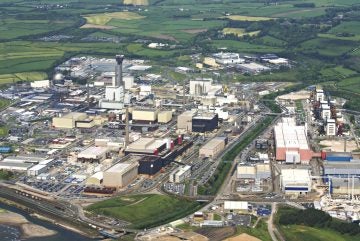
The UK National Audit Office (NAO), which scrutinises public spending for Parliament and is independent of government, has urged improvements at the Nuclear Decommissioning Authority’s (NDA’s) Sellafield site. The 51-page report, Decommissioning Sellafield: managing risks from the nuclear legacy, is an update to its previous report published in 2018.
Sellafield is the UK’s most complex and challenging nuclear site with highly hazardous materials stored there from across the UK’s nuclear industry. It also holds a legacy of contaminated buildings, untreated waste and ageing facilities. The government considers that some of these buildings and their contents pose an “intolerable” risk, reduction of which must be the overriding factor in the decision-making of the NDA. While workers at Sellafield have started retrieving and safely storing waste, the NDA expects full site remediation will take until 2125.
NDA, an executive non-departmental body sponsored by the Department of Energy Security and Net Zero, is currently responsible for operating, decommissioning and cleaning up 17 nuclear sites in the UK. Seven more sites are due to be added to its remit.
The NAO report examines progress made since 2018 and, in particular, the extent to which the NDA and Sellafield have improved on the issues previously identified. It covers:
- Governance and oversight of nuclear decommissioning: The extent to which the NDA’s reforms since 2018 are securing benefits and improving governance and oversight of decommissioning risks.
- Progress to date in managing risks from the nuclear legacy: How well Sellafield has performed since 2018 on managing risks from the nuclear legacy and what more it needs to do.
- Understanding future risks and planning: Sellafield’s ability to assess and understand current and emerging decommissioning risks and to put in place short- and long-term plans to address these.
Report director, Charles Nancarrow, Head of Financial Analysis NAO noted: “It is now 20 years since the NDA was set up to manage the UK’s nuclear legacy, and eight years since it brought the Sellafield site back under its direct control. However, Sellafield is still in the early stages of delivering its mission of cleaning up the Sellafield site…. This is an exceptionally challenging mission: Sellafield needs to build new facilities to treat and store different types of nuclear waste, while continuing to maintain ageing facilities and their supporting infrastructure until they can be emptied of waste and decommissioned.”
He added that Sellafield has made progress since 2018. “It has demonstrated that it is possible to retrieve the most hazardous waste from four of its oldest stores and store it in a way which meets modern safety standards, and the reorganisation of the NDA is bringing benefits. Increasingly, Sellafield is able to draw on expertise from elsewhere in the NDA group and it is taking action to improve performance on major projects. There are also some recent signs that Sellafield is more willing to confront and resolve difficult issues.”
However, despite these improvements, “We cannot yet say that the NDA and Sellafield are achieving value for money – by which we mean outcomes commensurate with the considerable expenditure on the site. Large projects are still being delivered later than planned and at higher cost. Sellafield has made slower progress in reducing site risks than it would have liked and must now significantly accelerate the pace at which it is retrieving waste from its oldest storage facilities.”
In addition, Sellafield “needs to address the deteriorating condition of key assets and develop credible plans for maintaining the analytical capabilities the site depends upon and improving (and sustaining) its workforce’s capability”. It still “lacks a comprehensive measure to assess progress in reducing risk”. He concluded: “If it underperforms, the cost of completing its mission will increase considerably, and ‘intolerable’ safety risks will persist for longer.”
Gareth Davies, head of the NAO, also acknowledged that Sellafield and the NDA had made progress on numerous fronts since 2018 but listed continuing concerns. “For the first time, Sellafield safely removed certain types of hazardous waste, including in March 2024 removing a zeolite skip, used to absorb radiation, from the First Generation Magnox Storage Pond (FGMSP),” he said.
NDA has reorganised itself to address significant contractual, delivery and procurement problems. Historically, it had contracted out management of nuclear sites to the private sector. The NDA began reversing this trend in 2016, starting with Sellafield. From 2018-2023 it created a group subsidiary management structure, allowing it to seek savings through economies of scale and improve operational effectiveness, via sharing staff between sites.
Davies noted that tensions have existed between Sellafield, the NDA and the Office for Nuclear Regulation (ONR). Since 2023, Sellafield’s chief executive and other members of the senior leadership team have left, and there are signs – via staff survey results and willingness by new senior management to confront problems – that the organisation’s culture is improving.
However, in 2023, Sellafield paid out £2.1m ($2.7m) more in staff bonuses than it should have done – around £200 per person. Its senior management treated one missed target as if it had been met, and omitted another missed target from its assessment of how well the organisation had performed, so the bonus payable was not reduced.
Although Sellafield has demonstrated that it can safely remove the most hazardous material from ageing buildings “progress isn’t quick enough for it to be able to guarantee that facilities used to treat the waste will reach the end of their useful lives before all the waste is retrieved,” Davies said in a press release.
Compared with 2018, milestones for substantially emptying three of the legacy ponds and silos have been pushed back by between six and 13 years. Sellafield is hoping to significantly accelerate the pace of retrievals; in the most optimistic scenario, by the mid-2030s it will be retrieving 546 boxes of waste from the Magnox Swarf Storage Silo (MSSS) each year (24 times as much as it did in 2023-24).
Davies also reported that four of the major projects the NAO last reported on in 2018 (and which had started construction), “are expected to cost £1.15 billion more and be delivered 58-129 months later than previously forecast”. Major projects started more recently are currently in line with their business cases, with one notable exception that is vital to the safe and effective running to the site. This involves Sellafield’s sample analysis facilities, which are 70 years old and in extremely poor condition.
Work to replace Sellafield’s sample analysis facilities begun in 2016, with Sellafield deciding to convert another laboratory on the site; but work was paused more than seven years after work began and at an already incurred cost of £265m. “Refurbishment of the existing sample analysis facility is now the preferred option, but Sellafield cannot yet confirm the viability of this decision,” Davies noted.
He added that recruitment concerns are hampering Sellafield’s approach to improving cyber security following the site’s prosecution for related breaches/failings earlier this year. “Like other areas of the civil service, it faces an increasing threat amid the challenge of recruiting people with the skills it needs. Future asset management challenges arise from poor data, as Sellafield doesn’t know how long key assets will need to remain operational, nor how long they are likely to last.”
Staffing challenges remain, and Sellafield is developing a workforce plan to address issues which have affected operations in recent years. In October 2023, the Sellafield board decided to prioritise addressing workforce capability above achieving commitments made to the Treasury at the Spending Review 2021. The decision followed Sellafield’s safety assurance team, in 2022, expressing serious concerns about the workforce’s capability to safely operate facilities and maintain assets. The site depends upon a highly skilled workforce, and faces increasing competition from civil and military nuclear programmes.
“The NDA needs to build new facilities to treat and store different types of nuclear waste, while maintaining ageing facilities and associated infrastructure until they can be decommissioned,” Davies said. “Despite progress achieved since the NAO last reported, I cannot conclude Sellafield is achieving value for money yet, as large projects are being delivered later than planned and at higher cost, alongside slower progress in reducing multiple risks.”
The report makes several recommendations. Sellafield should:
- Develop an approach that demonstrates to stakeholders that effective progress is being made towards decommissioning the site. This should cover enabling activities and include progress to date at Sellafield, while also supporting future funding choices and Spending Review decisions;
- Carry out an assessment of the culture across the site and develop suitable metrics to assess and monitor whether all areas of the site and its leadership are positively contributing to creating a high performing public sector organisation.
The NDA and its group subsidiaries, should:
- Develop measures to assess the operational effectiveness of its sites. In particular, it should monitor whether Sellafield is maintaining the capability needed to continue to operate safely and deliver progress with the mission.
The NDA, DESNZ and HM Treasury should:
- Consider what information and evidence from the NDA group would be needed to be able to demonstrate the value of longer-term settlements. In this context, the NDA should explore whether longer-term budgets for Sellafield are feasible.
NDA Group CEO, David Peattie, said: “The NDA and Sellafield welcome this report, and its recognition of the progress on numerous fronts at Sellafield since the last report in 2018, including benefits achieved through the new NDA group model. Sellafield is one of the most complex environmental programmes in the world. We’re proud of our workforce and achievements being made, including the unprecedented retrieval of legacy waste from all four highest hazard facilities.”
He added: “But as the NAO rightly points out there is still more to be done. This includes better demonstrating we are delivering value for money and the wider significant societal and economic benefits through jobs, the supply chain, and community investments. With the support of our workforce, community, and stakeholders we remain committed to driving forward improved performance and continuing to deliver our nationally important mission safely, securely, and sustainably.”
Josh MacAlister, MP for the local Whitehaven & Workington communities, told Cumbria Crack: “This report gives us some things to celebrate and some things which the NDA needs to address as a matter of urgency. I echo the positive comments made about the new leadership at Sellafield. The new leadership team needs the time and space to show that they can deliver value for money. Workforce challenges are a clear and consistent theme and I want to see action to address this. We need a proper, long-term skills plan, coupled with serious investment in our communities by the NDA so that we’re a place young people want to stay and a destination to attract new talent into west Cumbria.”






